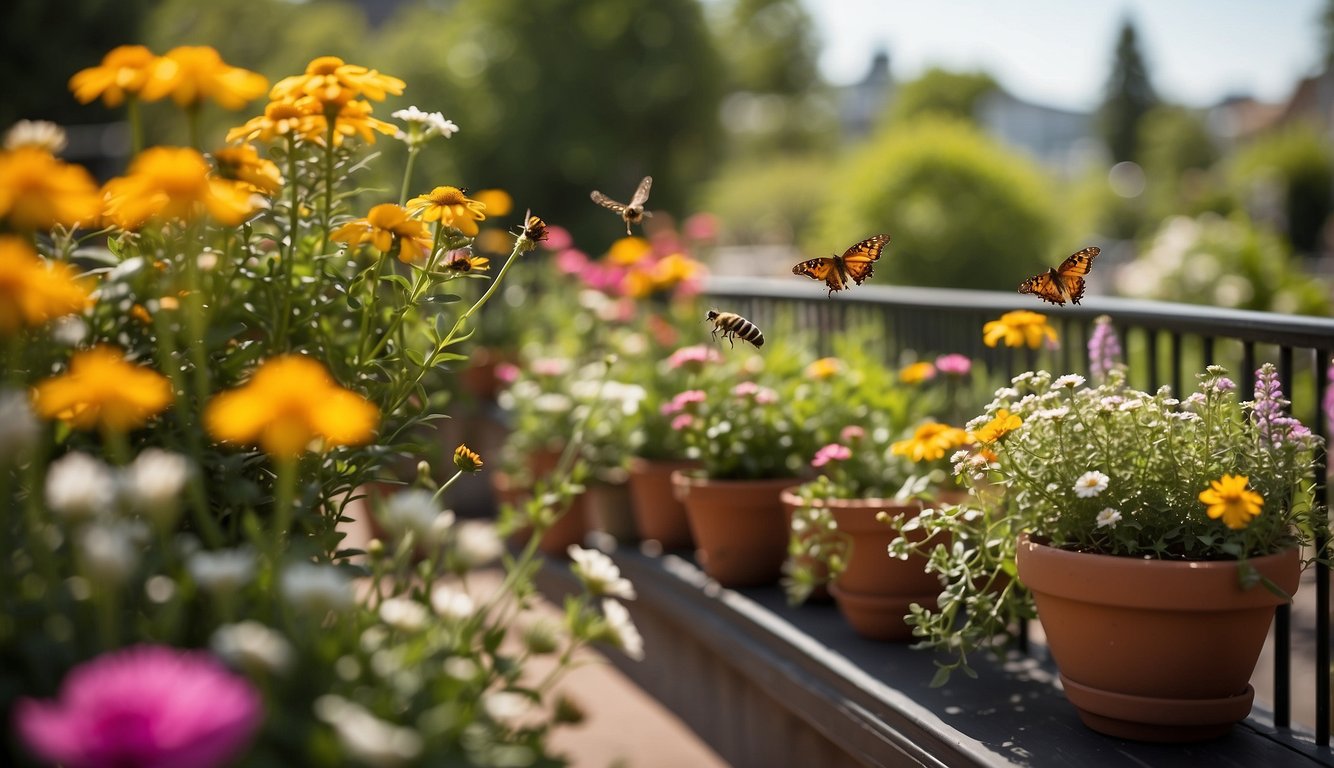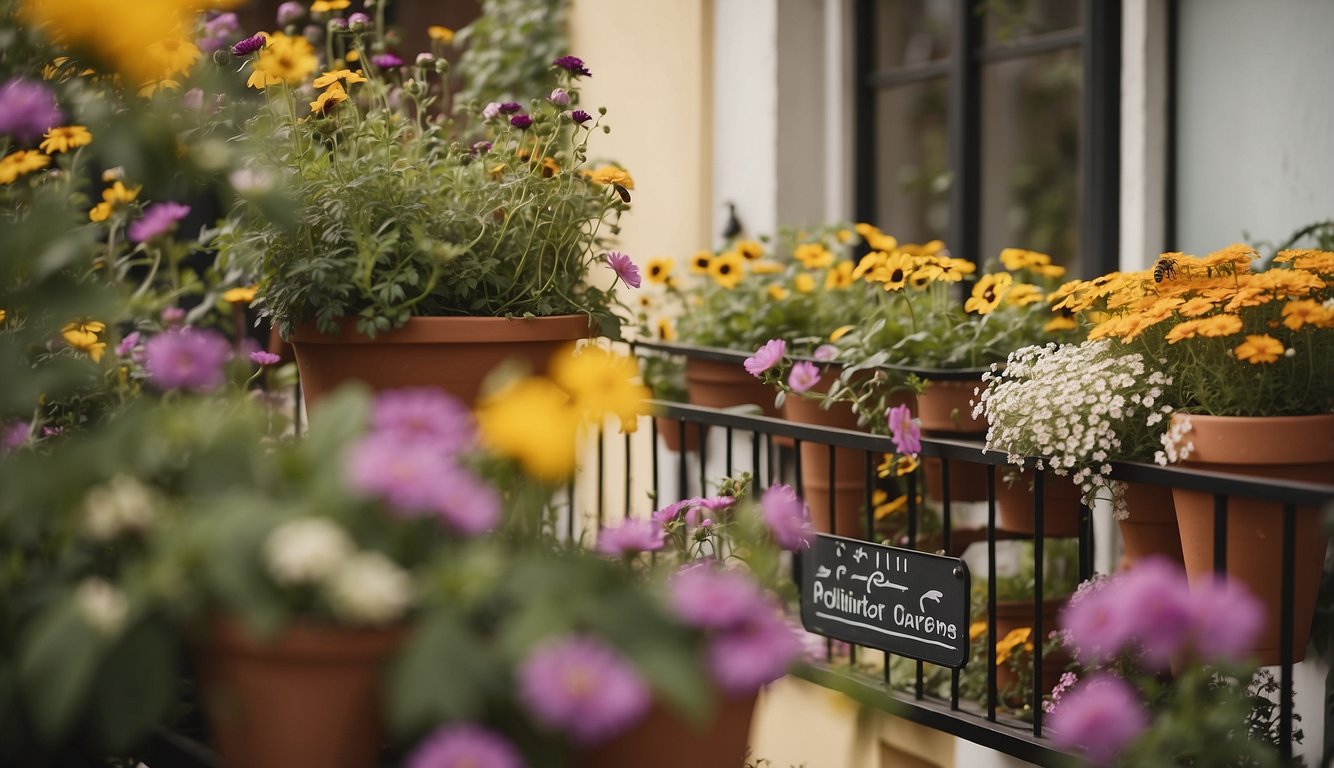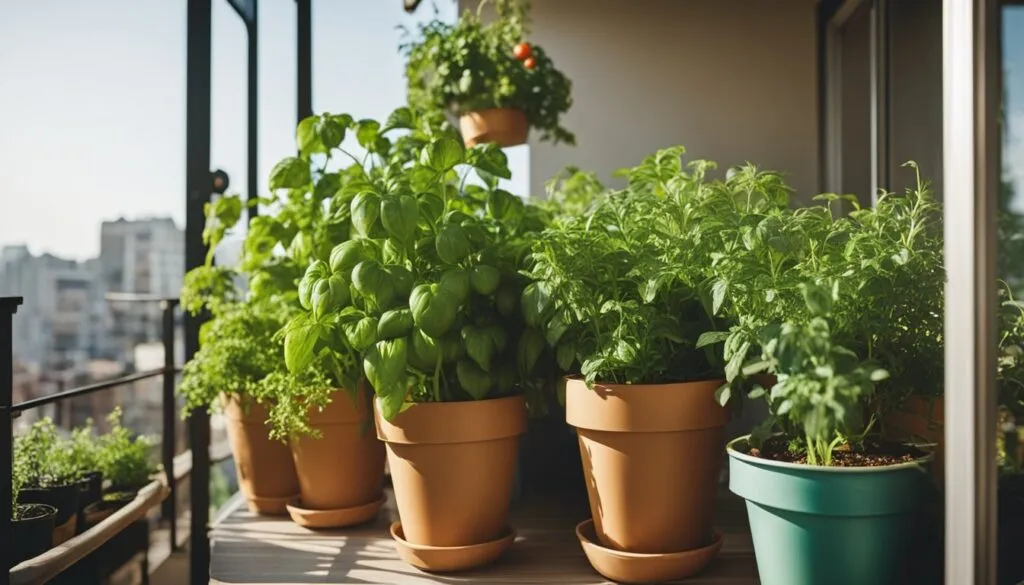Pollinators are essential for the growth and reproduction of many plants, including those that provide us with food. Unfortunately, many pollinator populations are declining due to habitat loss, pesticide use, and other factors. One way we can help support pollinators is by creating pollinator-friendly gardens, even on our balconies.

In this article, we will explore how to plan and create a pollinator-friendly balcony garden. We will discuss the importance of selecting the right plants, creating a habitat for pollinators, and maintaining your garden. We will also address special considerations for those living in urban areas. By the end of this article, you will have the knowledge and tools you need to create a beautiful and thriving pollinator garden on your balcony.
Table of Contents
Key Takeaways
- A pollinator-friendly balcony garden can help support pollinator populations and promote plant growth and reproduction.
- When planning your garden, it is important to select native plants that provide food and habitat for pollinators.
- Creating a habitat for pollinators involves providing shelter, water, and nesting sites, as well as minimizing pesticide use and providing a variety of flowering plants throughout the growing season.
Planning Your Pollinator Garden

When it comes to planning your pollinator-friendly balcony garden, there are several factors to consider. We’ll cover some of the most important ones below.
Location and Size
The first step in planning your pollinator garden is to choose the location and size of your garden. Choose a spot on your balcony that gets the most sun. Most pollinator plants require full sun, but if your balcony is in a shady location, that’s okay too. Certain pollinator plants grow in the shade.
Determine the size of your garden based on the available space on your balcony. You can create a small garden in a raised bed or a large garden in containers.
Soil and Water
The next step is to consider the soil and water requirements of your pollinator plants. Choose a high-quality potting mix that is well-draining and nutrient-rich. Make sure to water your plants regularly, especially during hot and dry weather.
Climate and Planting Season
Consider the climate of your region and the planting season for your pollinator plants. Some plants thrive in cooler temperatures, while others prefer warmer weather. Choose plants that are suitable for your climate and planting season.
Garden Design and Sunlight
When designing your pollinator garden, consider the sunlight requirements of each plant. Place plants that require full sun in the sunniest part of your balcony and those that prefer shade in the shadier areas.
You can also create a beautiful and functional garden design by grouping plants together based on their color and shape. This will not only make your garden look more attractive but also attract more pollinators.
Containers and Raised Beds
Containers and raised beds are great options for balcony gardens. They provide good drainage, allow for easy movement of plants, and can be arranged in different configurations to suit your space.
In summary, planning your pollinator-friendly balcony garden requires careful consideration of the location, size, soil, water, climate, planting season, garden design, sunlight, and container options. By following these guidelines, you can create a beautiful and thriving garden that will attract pollinators and benefit the environment.
Selecting the Right Plants
When it comes to creating a pollinator-friendly balcony garden, selecting the right plants is crucial. We want to choose plants that provide nectar and pollen for pollinators, as well as host plants for caterpillars. Native plants are a great choice because they have evolved alongside local pollinators and are well-suited to your region’s climate and soil conditions.
We can choose from a variety of plants, including flowering plants, perennials, annuals, trees, shrubs, wildflowers, and herbs. Some great options include milkweed, aster, sunflowers, and goldenrods. These plants bloom at different times throughout the growing season, providing a continuous source of food for pollinators.
When selecting plants, we should also consider the size of our balcony and the amount of sunlight it receives. Some pollinator plants require full sun, while others can grow in the shade. It’s important to choose plants that will thrive in the conditions of our balcony.
To make it easier to choose plants that are native to our region, we can consult with a local nursery or use online resources such as the U.S. Department of Agriculture’s Plants Database. This database allows us to search for plants based on our location and other criteria.
In summary, selecting the right plants is essential for creating a pollinator-friendly balcony garden. We should choose plants that provide nectar and pollen for pollinators, as well as host plants for caterpillars. Native plants are a great choice, and we can consult with a local nursery or use online resources to find plants that are well-suited to our region.
Creating a Habitat for Pollinators

To create a pollinator-friendly balcony garden, we need to provide a habitat that meets the needs of pollinators. Pollinators require shelter, food, water, nesting sites, larval host plants, and a diverse environment. Here are some tips on how to create a habitat for pollinators:
Shelter
Pollinators need shelter to protect themselves from the elements and predators. We can provide shelter by planting a variety of plants that offer different heights and textures. For example, we can plant tall grasses, shrubs, and trees to provide shelter for birds and butterflies. We can also add a bee house to provide shelter for solitary bees.
Food Source
Pollinators need a variety of nectar and pollen-rich plants for food. We can plant flowers that bloom at different times of the year to provide a continuous food source for pollinators. We can also include native plants that are adapted to our local climate and soil conditions. Some examples of pollinator-friendly plants include milkweed, coneflower, and bee balm.
Water
Pollinators need water to drink and to keep themselves cool. We can provide water by placing a shallow birdbath or a saucer filled with water in our garden. We can also create a muddy patch in a corner of our balcony to provide a source of moisture for butterflies and bees.
Nesting Sites
Pollinators need nesting sites to lay their eggs and raise their young. We can provide nesting sites by adding a hummingbird nest or a birdhouse to our balcony garden. We can also leave some areas of bare soil or dead wood to provide nesting sites for ground-nesting bees.
Larval Host Plants
Some pollinators, such as butterflies, require specific larval host plants to lay their eggs on. We can include larval host plants such as milkweed, parsley, and fennel in our balcony garden to provide food for caterpillars.
Diversity
A diverse environment is essential for a healthy pollinator habitat. We can create a diverse environment by planting a variety of plants, including trees, shrubs, and flowers. We can also include different types of pollinators, such as bees, butterflies, and hummingbirds, in our garden.
By following these tips, we can create a habitat for pollinators on our balcony and help support the important work that they do.
Maintaining Your Garden

Maintaining your pollinator-friendly balcony garden is essential for its health and longevity. Here are some tips to keep your garden looking beautiful and thriving.
Watering
Watering is crucial for the health of your plants. We recommend watering your garden deeply once a week rather than giving it a light watering every day. This will encourage deeper root growth and make your plants more drought-tolerant. Be sure to water the soil, not the leaves, to prevent disease.
Mulching
Mulching is an excellent way to keep your garden healthy and weed-free. We recommend using a nutrient-rich mulch such as compost or shredded leaves. Mulch helps to retain moisture, regulate soil temperature, and suppress weed growth.
Composting
Composting is a great way to add nutrients to your soil. We recommend starting a compost bin or purchasing compost from a local garden center. Compost is rich in nutrients and beneficial microorganisms that will help your plants grow strong and healthy.
Pruning
Pruning is essential for maintaining the shape and health of your plants. We recommend pruning dead or damaged branches, as well as any branches that are crossing or rubbing against each other. Pruning also encourages new growth and helps to keep your plants looking tidy.
Pesticides
Avoid using pesticides in your garden as much as possible. Pesticides can harm beneficial insects such as bees and butterflies, which are essential for pollination. Instead, try using natural pest control methods such as companion planting or handpicking pests.
By following these tips, you can maintain a healthy and thriving pollinator-friendly balcony garden.
Special Considerations for Urban Areas

When it comes to creating a pollinator-friendly balcony garden in an urban area, there are a few special considerations to keep in mind. Urban areas can present unique challenges such as limited outdoor space, lack of soil, and exposure to pollution. However, with some careful planning and consideration, we can still create a thriving pollinator garden on our balconies.
Choosing the Right Containers
One of the most important considerations for an urban balcony garden is choosing the right containers. Since we are likely dealing with limited space, we want to make the most of it by using pots, containers, wall planters, trellises, and window boxes. We recommend using lightweight containers made of materials such as plastic or fiberglass to reduce the overall weight on your balcony. Also, make sure to choose containers that are large enough to accommodate the root systems of the plants you want to grow.
Soil Considerations
Another thing to consider when creating a balcony pollinator garden in an urban area is the quality of the soil. Since we are likely dealing with limited soil, we recommend using a high-quality potting mix that is specifically designed for container gardening. This will help ensure that your plants have the nutrients they need to thrive. Additionally, you may want to consider adding compost or other organic matter to your soil to improve its quality.
Vertical Gardening
In an urban area, we may not have a lot of horizontal space for our garden, but we can make use of vertical space. Vertical gardening is a great way to maximize our available space and create a stunning display of plants. We can use trellises, wall planters, and hanging baskets to grow plants vertically. This not only saves space but also creates an eye-catching display.
Outdoor Space
Finally, it’s important to consider the overall outdoor space when creating a pollinator-friendly balcony garden in an urban area. We want to make sure that our plants have access to plenty of sunlight, and we also want to consider the impact of pollution on our plants. If possible, try to choose a balcony that is not directly facing a busy street, and consider using plants that are known to be tolerant of pollution.
By taking these special considerations into account, we can create a beautiful and thriving pollinator-friendly balcony garden in an urban area. With a little bit of planning and care, we can help support the important work of pollinators and enjoy the beauty of nature right outside our door.
Conclusion
Creating a pollinator-friendly balcony garden is a great way to contribute to conservation efforts and promote biodiversity in your community. By providing a habitat for pollinators like bees, butterflies, and hummingbirds, we can help support the delicate balance of our ecosystem.
In addition to its environmental benefits, a pollinator-friendly balcony garden can also be a great educational tool. By learning about the different types of pollinators and the plants they rely on, we can deepen our understanding of the natural world and inspire others to do the same.
Community involvement is also an important aspect of pollinator-friendly balcony gardens. By sharing our knowledge and experiences with others, we can encourage more people to create their own pollinator-friendly gardens and contribute to the larger conservation effort.
To create a successful pollinator-friendly balcony garden, it is important to choose the right plants, provide shelter and nesting sites, ensure a water source, avoid pesticides and herbicides, create sun and shade areas, design for continuous blooming, and keep a variety of pollinators in mind. By following these guidelines, we can create a beautiful and sustainable garden that benefits both pollinators and our community.
Frequently Asked Questions

What are the best plants to attract bees and other pollinators in small balcony spaces?
There are many plants that can attract bees and other pollinators to your small balcony garden. Some of the best plants include lavender, salvia, sunflowers, and zinnias. These plants are not only attractive to pollinators, but they also thrive in small spaces and require minimal maintenance.
How can I create a pollinator-friendly garden in a limited space like a balcony?
Creating a pollinator-friendly garden on a balcony is easier than you might think. Start by choosing the right location that gets the most sun. Most pollinator plants require full sun, but if your balcony is in a shady location, that’s okay too. Certain pollinator plants grow in the shade. Determine the size of your garden and choose plants that are appropriate for your space. Make sure to plant flowers with different shapes, colors, and sizes to attract a variety of pollinators.
Which native plants should I consider for a balcony garden to support local pollinators?
Choosing native plants is a great way to support local pollinators. Some of the best native plants for a balcony garden include black-eyed Susan, butterfly weed, and purple coneflower. These plants are not only beautiful, but they also provide food and shelter for local pollinators.
What are the essential elements to include in a balcony garden to make it welcoming for pollinators?
To make your balcony garden welcoming for pollinators, you should include a variety of plants that bloom at different times of the year. You should also provide a water source for pollinators, such as a shallow dish filled with water. Additionally, you can provide nesting sites for bees and butterflies by adding a bee hotel or butterfly house to your balcony.
How do I maintain a pollinator garden on my balcony throughout the different seasons?
Maintaining a pollinator garden on your balcony is easy if you follow a few simple tips. Make sure to water your plants regularly, especially during the hot summer months. Deadhead your flowers regularly to encourage new growth and blooming. Remove any dead or diseased plants to prevent the spread of disease. Finally, add compost or organic fertilizer to your soil to keep it healthy and nourished.
Can a balcony garden be effective in urban areas for supporting biodiversity and pollinators?
Yes, a balcony garden can be effective in urban areas for supporting biodiversity and pollinators. In fact, balcony gardens can be a great way to support biodiversity in urban areas where green space is limited. By providing food, shelter, and water for pollinators, you can help support local ecosystems and promote biodiversity in your community.


